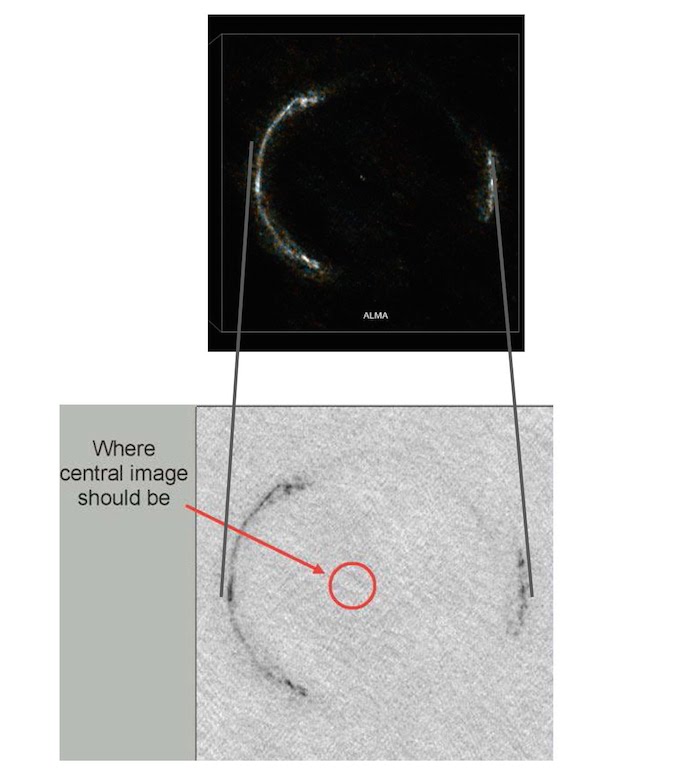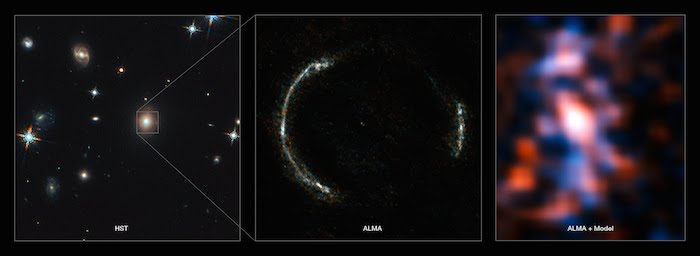The left panel shows the foreground lensing galaxy (observed with Hubble), and the gravitational lens system SDP.81, which forms an almost perfect Einstein Ring but is hardly visible. The middle image shows the sharp ALMA image of the Einstein Ring. The foreground lensing galaxy is invisible to ALMA, as it does not emit strong submillimeter-wavelength light. The resulting reconstructed image of the distant galaxy (right) using sophisticated models of the magnifying gravitational lens reveals fine structures within the ring that have never been seen before: several giant clouds of dust and cold molecular gas, which are the birthplaces of stars and planets. Credit: ALMA (NRAO/ESO/NAOJ)/Y. Tamura (The University of Tokyo)/Mark Swinbank (Durham University).
.
By analyzing the high-resolution data and modeling the gravitational lensing effect, the team determined that the massive lensing galaxy contains over 350 billion times the mass of the sun within the ring. Wong, together with Suyu and Matsushita, analyzed the central regions of SDP.81 and found the predicted central image of the background galaxy to be extremely faint. Lensing theory predicts that the central image of a lensing system is very sensitive to the mass of a supermassive black hole in the lens galaxy: the more massive the black hole, the fainter the central image. From this, they calculated that the supermassive black hole, located very close to the center of the SDP.81, may contain over 300 million times the mass of the sun.
The first author of the article, Dr. Kenneth Wong, explained the information behind this image. He says almost all massive galaxies seem to have supermassive black holes at their centers, “they can be millions, or even billions of times more massive than the sun. However, we can only directly calculate the mass for very nearby galaxies. With ALMA, we now have the sensitivity to look for the central image of the lens, which can allow us to determine the mass of much more distant black holes.” Measuring the masses of more distant black holes is the key to understanding their relationship with their host galaxies and how they grow over time, he added.
“This is the highest-resolution image of a gravitational lens that has ever been taken,” said Wong, “The amount of detail in this image is much greater than even space telescope observations,”
“ALMA opens a new frontier to weigh supermassive black holes at centers of lensing galaxies, which cannot be done previously with optical telescopes,” said coauthor Sherry Suyu of ASIAA.
“With the high-resolution capabilities of ALMA, which we helped to realize in the last 5 years, it is now possible to perform new science that cannot be done with any other instrument,” said coauthor Satoki Matsushita of ASIAA.
Drs. Wong, Suyu, and Matsushita, along with collaborators in Japan, have been awarded time on ALMA within the next year to observe a more distant gravitational lens similar to SDP.81, one which they anticipate will have a brighter central image that could directly constrain the mass of the supermassive black hole. With the capabilities of ALMA, they hope to continue investigating the formation and evolution of these massive galaxies and their supermassive black holes.
The Atacama Large Millimeter/submillimeter Array (ALMA), whose construction was participated by teams across the globe, is the biggest radio telescope array in the world. Construction began in 1998 and the telescope was inaugurated in March 2013. ALMA is composed of 54 12-meter antennae and 12 7-meter antennae that all work together at millimeter and submillimeter wavelengths to achieve an angular resolution of 0.01 arcseconds. ALMA provides advanced accurate data for studies of the relic radiation from the early Universe, molecular gas, and interstellar dust.
Quelle: Institute of Astronomy and Astrophysics, Academia Sinica



